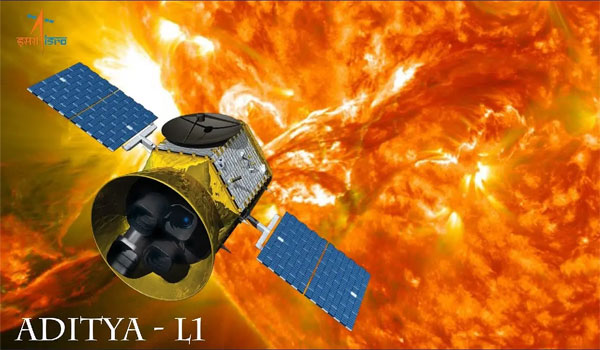All about ADITYA -L1; the first space based Indian mission to study the Sun!

Aditya L1 shall be the first space based Indian mission to study the Sun. The spacecraft shall be placed in a halo orbit around the Lagrange point 1 (L1) of the Sun-Earth system, which is about 1.5 million km from the Earth.
A satellite placed in the halo orbit around the L1 point has the major advantage of continuously viewing the Sun without any occultation/eclipses. This will provide a greater advantage of observing the solar activities and its effect on space weather in real time. The spacecraft carries seven payloads to observe the photosphere, chromosphere and the outermost layers of the Sun (the corona) using electromagnetic and particle and magnetic field detectors. Using the special vantage point L1, four payloads directly view the Sun and the remaining three payloads carry out in-situ studies of particles and fields at the Lagrange point L1, thus providing important scientific studies of the propagatory effect of solar dynamics in the interplanetary medium.
The suits of Aditya L1 payloads are expected to provide most crucial information to understand the problem of coronal heating, coronal mass ejection, pre-flare and flare activities and their characteristics, dynamics of space weather, propagation of particle and fields etc.
The major science objectives of Aditya-L1 mission are:
- Study of Solar upper atmospheric (chromosphere and corona) dynamics.
- Study of chromospheric and coronal heating, physics of the partially ionized plasma, initiation of the coronal mass ejections, and flares
- Observe the in-situ particle and plasma environment providing data for the study of particle dynamics from the Sun.
- Physics of solar corona and its heating mechanism.
- Diagnostics of the coronal and coronal loops plasma: Temperature, velocity and density.
- Development, dynamics and origin of CMEs.
- Identify the sequence of processes that occur at multiple layers (chromosphere, base and extended corona) which eventually leads to solar eruptive events.
- Magnetic field topology and magnetic field measurements in the solar corona.
- Drivers for space weather (origin, composition and dynamics of solar wind.
- The instruments of Aditya-L1 are tuned to observe the solar atmosphere mainly the chromosphere and corona. In-situ instruments will observe the local environment at L1. There are total seven payloads on-board with four of them carrying out remote sensing of the Sun and three of them carrying in-situ observation.
Payloads along with their major capability of scientific investigation
|
Type |
Sl. No. |
Payload |
Capability |
|
Remote Sensing Payloads |
1 |
Visible Emission Line Coronagraph(VELC) |
Corona/Imaging & Spectroscopy |
|
2 |
Solar Ultraviolet Imaging Telescope (SUIT) |
Photosphere and Chromosphere Imaging- Narrow & Broadband |
|
|
3 |
Solar Low Energy X-ray Spectrometer (SoLEXS) |
Soft X-ray spectrometer: Sun-as-a-star observation |
|
|
4 |
High Energy L1 Orbiting X-ray Spectrometer(HEL1OS) |
Hard X-ray spectrometer: Sun-as-a-star observation |
|
|
In-situ Payloads |
|||
|
5 |
Aditya Solar wind Particle Experiment(ASPEX) |
Solar wind/Particle Analyzer Protons & Heavier Ions with directions |
|
|
6 |
Plasma Analyser Package For Aditya (PAPA) |
Solar wind/Particle Analyzer Electrons & Heavier Ions with directions |
|
|
7 |
Advanced Tri-axial High Resolution Digital Magnetometers |
In-situ magnetic field (Bx, By and Bz). |













